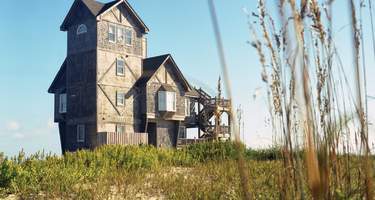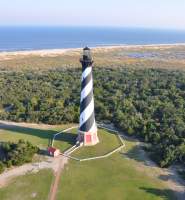Rodanthe, NC
At first glance, the villages of Rodanthe, Waves and Salvo seem to be one town. In fact, many folks – locals and visitors alike – call them “The Tri-Villages.” Their borders touch and one village appears to run seamlessly into the next, but to many – locals and longtime visitors alike – the villages are distinct places, each with a unique identity, history and personality. Why do the three villages appear to be one? A local legend says there was a time you could tell the three apart, but you needed the village limit signs to do so. That same legend claims surfers or beach loving vacationers wanted a souvenir to take home, so they stole the “Welcome to Waves” sign every time a new one went up until the powers that be decided to remove the signs permanently. Rodanthe? Waves? Salvo? What’s with the strange names? There are stories behind those names and the names these villages used to go by and you’ll learn those soon. What’s the difference between the villages? Let’s find out.
Today we call the northernmost town on Hatteras Island “Rodanthe,” but that wasn’t always the case. Originally named Chicamacomico by the Croatan peoples, a tribe of Algonquin Native Americans who, fittingly, named this spot “dwelling place by the big water.” A long and confusing name to see on a sign, Chicamacomico fairly rolls off the tongue, and when European settlers began to build homes and fish camps here, the name stuck. Sort of. To the families who lived here, North Chicamacomico or Big Kinnakeet or North Woods was just home. Still, the village needed a name and North Chicamacomico was it. Until 1874. That’s when the post office arrived and the United States Postal Service decided not to go with the long and rather beautiful “Chicamacomico” as the name for this place and instead call it “Rodanthe.” North Rodanthe to be precise (the next village south, Waves, was South Rodanthe).
The meaning of the word Rodanthe has been lost to time, but it’s since become synonymous with this lovely little beach town, a town that few outside the families who lived here and the intrepid travelers visiting the Outer Banks knew until a certain novel and a certain film – Nights in Rodanthe – put the town on the pop culture map. Yes, the novel is set here and they filmed the movie here, using the beach and the cedar-clad beach houses as the backdrop for a love story, but for those in the know, the town is more than just what appeared on screen.
Rodanthe is home to anglers and surfers, descendants of the men who established the United States Lifesaving Service (which later became the U.S. Coast Guard), and families who have called Hatteras Island home for generations. There are transplants here too, folks who found their way to the Outer Banks and fell in love, then discovered the slower pace and wild nature of Hatteras Island and found their forever home here.
As you enter Rodanthe, one of the first sights is the Chicamacomico Life-Saving Station, a collection of historic buildings that once housed the men, animals, and equipment needed to rescue ships stuck on the shoals offshore. Now a museum that tells the stories of daring rescues and the men who performed them, it’s a point of pride for the village and a place nearly every resident here has a connection to.
Explore More of Rodanthe
Camping On the Outer Banks, NC
For many, the thought of a vacation to North Carolina’s Outer Banks sounds relaxing and fun-filled. The area...
Read More12 on 12 | Iconic Stops Along Highway 12 on the Outer Banks
Windows down, sun-kissed and sandy, you’re cruising the Outer Banks looking for your next adventure....
Read MoreIslands of the Outer Banks: Which one is right for you?
Seaside destinations tend to pack tons of tourists onto overcrowded beaches, but not in the Outer Banks of North...
Read MoreThe Rodanthe Fishing Pier, one of the few remaining wooden fishing piers on the North Carolina Coast and one of two on Hatteras Island, distinguished Rodanthe from other villages. Here in Rodanthe, like in the other villages on the Island, fishing was a way of life, but not so much in the catching of fish as in the selling of fish. Rodanthe, being the northernmost village on the island, served as a sort of clearing house for the fresh catch. Fishermen from other villages came here to sell or arrange for the sale of their catch, which was then transported north to the villages of Manteo or Wanchese on Roanoke Island, or across the Pamlico Sound to fish houses on the mainland. Though the Fishing Pier isn’t a hub of commercial fish sales, it is a hotspot for anglers who cast their lines into the water hoping to catch something for the record books, the frying pan, or at least bragging rights.
Driving into the village, two things jump out: the tall row of dunes on the ocean-side and the tendrils of sand they send across Highway 12 in an attempt to move inland; and the beach houses with a mix of residential and rental homes that has a charm here. The weathered cedar shake siding. The seaward-facing balconies and widow’s walks offering unending views of the ocean. The skinny stilt legs holding up two- and three-story homes.
One more thing stands out in Rodanthe (and all throughout Hatteras Island): the lack of huge oceanfront hotels. Here you’ll find rental homes mixed in with the residential homes, and you’ll find five campgrounds where visitors can park their RVs, spend some time in a cabin or cabana, or pitch a tent for a rustic beach getaway (well, rustic in the “bathhouse, camp store, and restaurant nearby” sense of the word).
A couple of surf shops and surf instructors; places to rent surfboards, standup paddleboards, jet skis, and beach equipment; and gift shops are scattered throughout the village, but even the biggest – a Kitty Hawk Kites Shop and Adventure Center (with a ropes course standing out in front) – doesn’t become a focal point. Rather, locals and visitors find themselves surrounded by nature, with the ocean calling from one side and the Sound calling from the other.



















